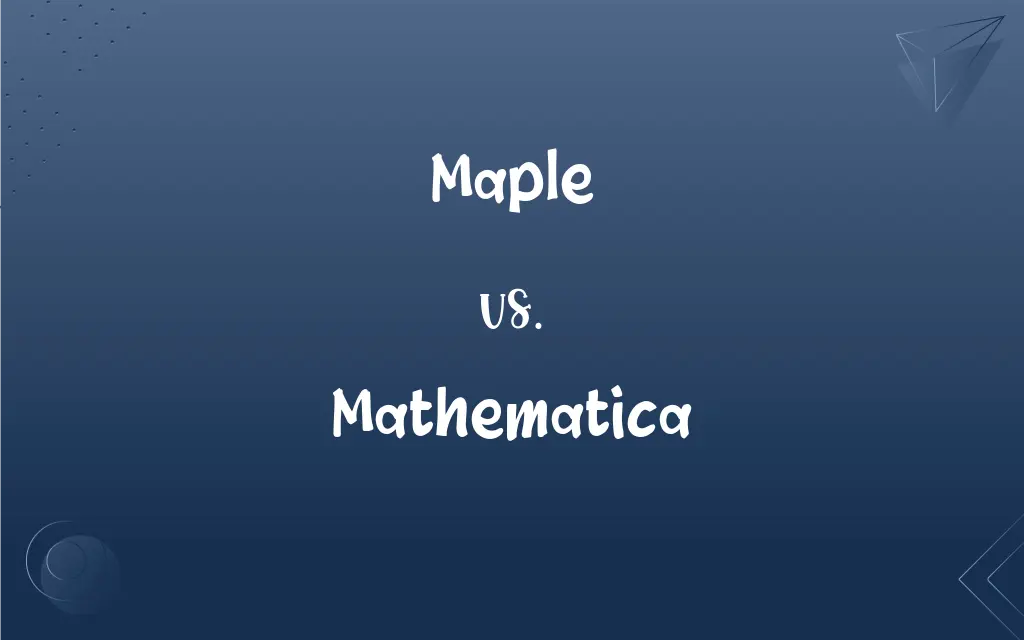Maple vs. Mathematica: What's the Difference?
Edited by Aimie Carlson || By Harlon Moss || Updated on October 12, 2023
Maple and Mathematica are both advanced computational software, but Maple prioritizes symbolic mathematics and exact solutions, whereas Mathematica emphasizes a balance between numerical and symbolic computations.

Key Differences
Maple is renowned for its proficiency in symbolic mathematics and algebraic computation, garnering significant appreciation among mathematicians and educators. Conversely, Mathematica encompasses a robust system that offers a balance between symbolic and numerical computations, proving its utility across various scientific domains. These applications have their individual strengths and functionalities that cater to diverse user needs and preferences in the realm of computational mathematics and related fields.
Widely utilized in academia, Maple has built its reputation upon potent symbolic computation capabilities and an intuitive interface conducive to educational contexts. On the other hand, Mathematica leans into a versatile computational framework that merges symbolic mathematics with substantial numerical computation capabilities, often finding application in research environments across varied disciplines like physics, engineering, and computational biology, in addition to mathematics.
One pivotal distinction lies in the user interface and experience offered by Maple and Mathematica. Maple often receives praise for its straightforward, user-friendly interface, which tends to be particularly approachable for beginners and educators aiming to elucidate complex mathematical concepts to students. In contrast, Mathematica is celebrated for its sophisticated, albeit steeper learning curve, interface that enables highly customizable and intricate computational explorations, catering particularly to researchers and professionals.
The programming language embedded within Maple is generally perceived as simpler and more direct, making it slightly more accessible for those newly navigating computational mathematics. Alternatively, Mathematica, with its own language, Wolfram Language, provides a richly detailed programming environment that, while potentially more complex, affords users a deeper and more nuanced control over computational processes and data visualization, appealing to seasoned researchers and professionals.
Documentation and community support serve as vital aspects to consider when evaluating Maple and Mathematica. Maple offers extensive documentation and a substantial repository of applications meant to facilitate educational pursuits. Mathematica, being part of the broader Wolfram ecosystem, brings to the table a vast array of documentation and a large, active community, providing users with a rich resource of pre-existing knowledge, problem-solving forums, and shared applications to navigate more complex computational dilemmas.
ADVERTISEMENT
Comparison Chart
Main Developer/Publisher
Maplesoft
Wolfram Research
Initial Release Date
1980
1988
Primary Purpose
Mathematical computing
Computational software
Programming Language Basis
Maple language
Wolfram Language
Symbolic Computation
Excellent
Excellent
ADVERTISEMENT
Numerical Computation
Very Good
Excellent
Graphic Capabilities
Excellent
Exceptional
User Interface
Friendly and intuitive
Advanced and complex
Application in Education
Widely used
Widely used
3D Plotting and Visualization
Extensive
Highly sophisticated
Documentation and Support
Comprehensive
Extensive
Community and Ecosystem
Robust
Very strong
Maple and Mathematica Definitions
Maple
Maple is a computer algebra system developed to perform mathematical computations and symbolical analyses.
The student used Maple to solve the complex algebraic equations from their assignment.
Mathematica
Mathematica provides a robust environment for users who need to perform intricate mathematical calculations and analyses.
Mathematica was pivotal in computing the complex numerical simulations in the physicist’s research.
Maple
Maple encompasses a wide array of tools specifically designed to explore, analyze, and visualize mathematical concepts and problems.
Using Maple, the professor was able to visually demonstrate the theorem to her students.
Mathematica
Mathematica uses its own programming language, Wolfram Language, which facilitates symbolic visualizations and algorithm developments.
Developers employ Mathematica to create algorithms for processing numerical data.
Maple
In Maple, users can leverage an intuitive interface to facilitate effective educational and instructional applications.
The mathematics tutor utilized Maple to illustrate challenging calculus problems in a more digestible manner.
Mathematica
Mathematica is a computational software system utilized in various scientific, engineering, and mathematical fields.
Researchers often use Mathematica to analyze large datasets efficiently.
Maple
Maple sustains a broad user base primarily within academia, offering a range of resources to support educational initiatives in mathematics.
The university recommended Maple for its mathematics courses due to its widespread academic adoption and supportive resources.
Mathematica
Mathematica is widely appreciated for its flexibility and power in tackling problems across mathematics, physics, and finance.
The financial analyst leveraged Mathematica to develop predictive models for stock prices.
Maple
Maple provides a programming language that is simplistic yet powerful, making it accessible to beginners and educators in mathematical computations.
Although new to computational mathematics, Karen found Maple’s programming language to be approachably straightforward.
Mathematica
Known for its symbolic and numerical computing capabilities, Mathematica can solve equations, plot graphs, and provide programming functionality.
Mathematica assisted in visualizing the data through its potent graph-plotting features.
Maple
Any of various chiefly deciduous trees or shrubs of the genus Acer of the Northern Hemisphere, having opposite, usually palmate leaves and fruits consisting of paired seeds attached to long wings.
Maple
The wood of any of these trees, especially the hard, close-grained wood of the sugar maple, often used for furniture and flooring.
FAQs
What is Maple primarily used for?
Maple is primarily used for symbolic mathematics and algebraic computations, often in an academic context.
Is Mathematica suitable for beginners in computational mathematics?
Mathematica may present a steeper learning curve for beginners but offers a rich, detailed computational environment.
Which software is better suited for data visualization?
Both offer potent data visualization tools, but Mathematica is often noted for its advanced and customizable visualization capabilities.
How is Maple utilized in advanced mathematical problem-solving?
Maple provides numerous tools and a powerful computational engine for tackling advanced mathematical problems and equations.
How versatile is Mathematica for various scientific applications?
Mathematica is extremely versatile, finding applications in numerous scientific fields, from physics to computational biology.
Is Maple employed in research contexts?
Yes, Maple is used in research, especially where symbolic computations and exact solutions are paramount.
Can Mathematica handle symbolic mathematics?
Yes, Mathematica can proficiently handle symbolic mathematics alongside its numerical capabilities.
How well does Mathematica integrate with other platforms and technologies?
Mathematica exhibits substantial integrative capabilities with various platforms and technologies, offering diverse functionality.
What kind of support and resources are available for Mathematica users?
Mathematica users have access to extensive documentation, an active user community, and a wide range of online resources and forums.
What distinguishes Mathematica in scientific computing?
Mathematica is known for its balance between symbolic and numerical computations and its application across various scientific disciplines.
How do the programming languages of Maple and Mathematica differ?
Maple’s language is typically seen as simpler and more direct, while Mathematica’s Wolfram Language is deeply nuanced and detailed.
How does Maple facilitate educational usage in mathematics?
Maple provides a range of tools, a simple language, and a user-friendly interface conducive for educators and students.
Are there any pre-built functions available in Mathematica?
Yes, Mathematica has a wide array of pre-built functions and capabilities for varied computational applications.
Which software, Maple or Mathematica, has a larger user community?
Both have robust user communities, but Mathematica, as part of the Wolfram ecosystem, might boast a slightly larger and more active user base.
Does Mathematica offer solutions for financial analytics?
Yes, Mathematica is utilized in financial analytics for creating models and analyzing data.
Can Maple be utilized in areas other than mathematics?
Absolutely, Maple is employed across varied disciplines, including engineering and physics, wherever mathematical computations are required.
Can Maple handle numerical computations?
Yes, Maple can handle numerical computations, but it is especially renowned for symbolic mathematics.
Can Maple be used for research in physics and engineering?
Yes, Maple can be utilized in physics and engineering research, especially for symbolical and analytical solutions.
Which software, Maple or Mathematica, provides a more user-friendly interface?
Maple is often praised for its user-friendly and intuitive interface, especially for beginners and educators.
Is it easy to share work created with Maple?
Yes, Maple allows users to share their work easily through various formats and MapleCloud.
About Author
Written by
Harlon MossHarlon is a seasoned quality moderator and accomplished content writer for Difference Wiki. An alumnus of the prestigious University of California, he earned his degree in Computer Science. Leveraging his academic background, Harlon brings a meticulous and informed perspective to his work, ensuring content accuracy and excellence.
Edited by
Aimie CarlsonAimie Carlson, holding a master's degree in English literature, is a fervent English language enthusiast. She lends her writing talents to Difference Wiki, a prominent website that specializes in comparisons, offering readers insightful analyses that both captivate and inform.
































































